Science in the street:
Science Fair 2016, Praha – Dejvice
VIDEO from the Prague Science Fair on YouTube
Postdoc research work in 60 seconds – video on YouTube
Popular science
Smaller than small, simple and complex.
(Author of the text and the images: Martin Kuthan)
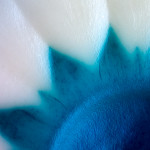 Microorganisms including yeasts are commonly viewed as simple single cell creatures when compared with more complex multicellular organisms including animals and plants. However, when grown on solid medium, yeasts are able to form multicellular communities called colonies. Colonies are not merely random piles of cells that all behave identically, but rather organised structures resembling tissues of higher organisms. Let’s go for a short journey into the fantastic world of the yeast colonies. Details of the colonies are hardly distinguishable from the details of higher organisms, like flowering plants. The close-up image shows the detail of the colony formed by genetically modified baker’s yeast Saccharomyces cerevisiae.
Microorganisms including yeasts are commonly viewed as simple single cell creatures when compared with more complex multicellular organisms including animals and plants. However, when grown on solid medium, yeasts are able to form multicellular communities called colonies. Colonies are not merely random piles of cells that all behave identically, but rather organised structures resembling tissues of higher organisms. Let’s go for a short journey into the fantastic world of the yeast colonies. Details of the colonies are hardly distinguishable from the details of higher organisms, like flowering plants. The close-up image shows the detail of the colony formed by genetically modified baker’s yeast Saccharomyces cerevisiae.
Blue tornadoes
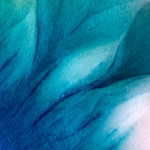 Shapes resembling tornado are complex patterns of gene expression in the colony formed by genetically modified yeast Saccharomyces cerevisiae. Blue and white colour represents the parts of the colony where the LacZ gene is switched ON or OFF, respectively.
Shapes resembling tornado are complex patterns of gene expression in the colony formed by genetically modified yeast Saccharomyces cerevisiae. Blue and white colour represents the parts of the colony where the LacZ gene is switched ON or OFF, respectively.
Blue tentacles
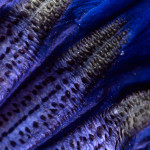 Complex patterns at the inner side of the trumpet-shaped flower of the Stemless gentian (Gentiana acaulis).
Complex patterns at the inner side of the trumpet-shaped flower of the Stemless gentian (Gentiana acaulis).
Like a brain
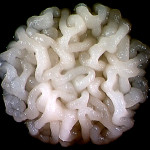 Close-up view of a colony of wild strain of the baker’s yeast Saccharomyces cerevisiae. Unlike their domesticated cousins used in laboratories and breweries, wild strains do form wrinkled fluffy colonies resembling brain structure.
Close-up view of a colony of wild strain of the baker’s yeast Saccharomyces cerevisiae. Unlike their domesticated cousins used in laboratories and breweries, wild strains do form wrinkled fluffy colonies resembling brain structure.
Tongue of an alien
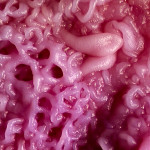 A detail of the colony of the yeast Candida mogii. This unicellular yeast is able to form multicellular colonies resembling tissues of higher organisms. Colonies are able to communicate using a volatile chemical signaling molecule – ammonia. The pH indicator added to the growth medium changes the colour of the colony to violet.
A detail of the colony of the yeast Candida mogii. This unicellular yeast is able to form multicellular colonies resembling tissues of higher organisms. Colonies are able to communicate using a volatile chemical signaling molecule – ammonia. The pH indicator added to the growth medium changes the colour of the colony to violet.
Alien creature
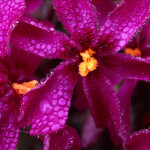 Dew covered flowers of the Mountain phlox (Phlox subulata). This plant with needle like evergreen leaves and white, rose, mauve or pink flowers is native to North America, but commonly found in rock gardens of many gardeners in Central Europe.
Dew covered flowers of the Mountain phlox (Phlox subulata). This plant with needle like evergreen leaves and white, rose, mauve or pink flowers is native to North America, but commonly found in rock gardens of many gardeners in Central Europe.
Fingers of an alien
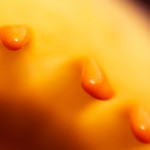 A close-up look into the flower of the White waterlily (Nymphaea alba). The floating flowers have white petals and yellow stigma surrounded by bright yellow stamens.
A close-up look into the flower of the White waterlily (Nymphaea alba). The floating flowers have white petals and yellow stigma surrounded by bright yellow stamens.
Meadow from above
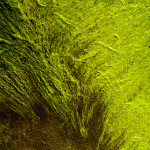 A granite rock at norwegian Sognefjord cowered by filamentous green algae. Without scale, it is hard to guess the real size of an object as small as few centimetres.
A granite rock at norwegian Sognefjord cowered by filamentous green algae. Without scale, it is hard to guess the real size of an object as small as few centimetres.
Earth from above
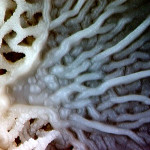 Wrinkled surface of a part of the wild strain of the baker’s yeast Saccharomyces cerevisiae. Many feral yeast strains do form stunning shapes and structures of their colonies. Without scale, it is hard to guess the real size of an object as small as few millimetres.
Wrinkled surface of a part of the wild strain of the baker’s yeast Saccharomyces cerevisiae. Many feral yeast strains do form stunning shapes and structures of their colonies. Without scale, it is hard to guess the real size of an object as small as few millimetres.
Blue sun
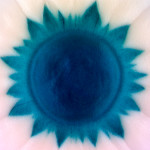 Central part of the yeast colony resembling a flower. Colony is formed by genetically modified yeast S. cerevisiae expressing LacZ gene controlled by MEP3 promoter. Blue and white colour represents the parts of the colony where the LacZ gene is switched ON or OFF, respectively.
Central part of the yeast colony resembling a flower. Colony is formed by genetically modified yeast S. cerevisiae expressing LacZ gene controlled by MEP3 promoter. Blue and white colour represents the parts of the colony where the LacZ gene is switched ON or OFF, respectively.
Yellow hole
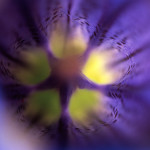 A view to the bottom of the flower of the Stemless gentian (Gentiana acaulis). The trumpet-shaped flowers are closing under harsh weather conditions.
A view to the bottom of the flower of the Stemless gentian (Gentiana acaulis). The trumpet-shaped flowers are closing under harsh weather conditions.
